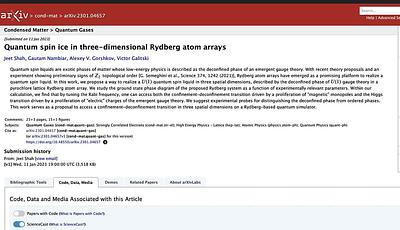By: Jeet Shah, Gautam Nambiar, Alexey V. Gorshkov, Victor Galitski
Quantum spin liquids are exotic phases of matter whose low-energy physics is described as the deconfined phase of an emergent gauge theory. With recent theory proposals and an experiment showing preliminary signs of Z2 topological order [G. Semeghini et al., Science 374, 1242 (2021)], Rydberg atom arrays have emerged as a promising platform to realize a quantum spin liquid. In this work, we propose a way to realize a U(1) quantum spin liquid ... more
Quantum spin liquids are exotic phases of matter whose low-energy physics is described as the deconfined phase of an emergent gauge theory. With recent theory proposals and an experiment showing preliminary signs of Z2 topological order [G. Semeghini et al., Science 374, 1242 (2021)], Rydberg atom arrays have emerged as a promising platform to realize a quantum spin liquid. In this work, we propose a way to realize a U(1) quantum spin liquid in three spatial dimensions, described by the deconfined phase of U(1) gauge theory in a pyrochlore lattice Rydberg atom array. We study the ground state phase diagram of the proposed Rydberg system as a function of experimentally relevant parameters. Within our calculation, we find that by tuning the Rabi frequency, one can access both the confinement-deconfinement transition driven by a proliferation of "magnetic" monopoles and the Higgs transition driven by a proliferation of "electric" charges of the emergent gauge theory. We suggest experimental probes for distinguishing the deconfined phase from ordered phases. This work serves as a proposal to access a confinement-deconfinement transition in three spatial dimensions on a Rydberg-based quantum simulator. less
By: Orazio Scarlatella, Rosario Fazio, Aashish Clerk and Marco Schirò
Several experimental platforms, such as superconducting circuits or ultracold atomic in optical lattices, nowadays allow to probe many-body physics in unprecedented regimes, such as in non-equilibrium conditions resulting from controlled dissipation and driving, but theoretical techniques for describing those regimes are limited.
In this work [1], we introduce an extension of the nonequilibrium dynamical mean-field theory (DMFT) for bosoni... more
Several experimental platforms, such as superconducting circuits or ultracold atomic in optical lattices, nowadays allow to probe many-body physics in unprecedented regimes, such as in non-equilibrium conditions resulting from controlled dissipation and driving, but theoretical techniques for describing those regimes are limited.
In this work [1], we introduce an extension of the nonequilibrium dynamical mean-field theory (DMFT) for bosonic lattice models described by Markovian master equations. DMFT maps these lattice problems onto a problem of a single site coupled to a classical field and to a non-interacting bath, accounting for leading corrections to Gutzwiller mean-field theory due to finite dimensionality. Our approach relies on a new method for solving the effective single-site problem based on a non-crossing approximation in the coupling to the DMFT bath, going beyond standard Born-Markov approximations [2].
We then discuss an application to a driven-dissipative Bose-Hubbard model with two-body losses and incoherent pump, computing its steady-state properties. DMFT captures hopping-induced processes that are completely missed by Gutzwiller mean-field theory, which are crucial to obtain the correct stationary-state, such as to describe its quantum-Zeno behaviour when the losses are strong, or to predict the critical hopping for a phase transition between an incoherent phase and a coherent, limit-cycle phase.
[1] O. Scarlatella, A. A. Clerk, R. Fazio, and M. Schiró, Dynamical Mean-Field Theory for Markovian Open Quantum Many-Body Systems, Phys. Rev. X 11, 031018 (2021).
[2] O. Scarlatella and M. Schiro, Self-Consistent Dynamical Maps for Open Quantum Systems, arXiv:2107.05553. less

